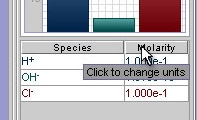For the following problems, we’ll consider the reaction
NaCl(aq) + AgNO3(aq) => NaNO3(aq) + AgCl(s)
Note that all of the aqueous species in the above reaction exists as ions in solution:
-
NaCl(aq) exists as Na+ and Cl-
AgNO3 exists as Ag+ and NO3-
NaNO3 exists as Na+ and NO3-

(For these problems, please click on the Molarity tab of the solution info pane to display units in grams)
1.) Use the virtual lab to answer the questions below.
- The solution labeled "1.00g NaCl" contains 1.00g of NaCl dissolved in water. Use the solution viewer to determine the number of grams of Na+ and Cl- in the solution, and confirm that these add to 1.00g.
- The solution labeled "1.00g AgNO3" contains 1.00g of solid AgNO3. Add 100ml of water to this solution. Use the solution viewer to determine the number of grams of Ag+ and NO3- in the solution.
- Now add the 1.00g of solid AgNO3 to the 1.00g solution of NaCl. Write down the mass of each species in solution and the mass of solid AgCl formed. Confirm that the amounts of these species are consistent with what you say in parts (2) and (3).
2.) The solution labeled "Solution 1" in the virtual lab stockroom contains 2.00 grams of Sodium Chloride.
- How many grams of Silver Nitrate must be added to the solution to completely react with Sodium Chloride according to the reaction above.
- Use the virtual lab to add that amount of Silver Nitrate to the solution. Check to make sure the reaction was complete, by making sure the amount of Ag+ and Cl- in the solution are both less than 0.01g.
3.) The solution labeled "Solution 2" in the virtual lab stockroom contains 3.00 grams of AgNO3.
- If excess NaCl is added to the solution, how many grams of AgCl(s) will be formed?
- Use the virtual lab to check your answer to part (a). Explain the laboratory procedure you used to perform this check.